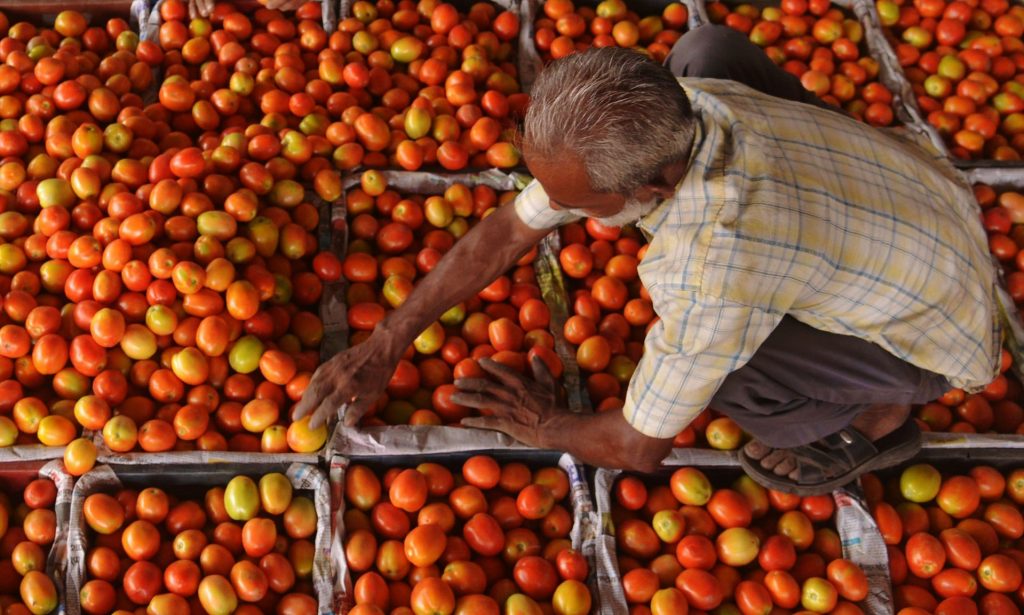
Photograph: Narinder Nanu/AFP/Getty Images
At Pimpalgaon Basant, a village in western India, there is not a single cloud in the sky. The last time it rained was days ago, and that was only for an hour. Without rain, the Pimpalgaon tomato market, said to be the biggest in Asia, is almost empty.
“We have around 75% fewer tomatoes than normal,” says Sheik Tanveer, who works at the market. “Normally, you can buy tomatoes wholesale for 10 rupees [10p] a kilo here – now you’ll get about 150g for that.”
Tomato prices across India have, on average, doubled since April, causing consternation across the country. A long drought, followed by an early monsoon has disturbed the harvest cycle, and scarcity has pushed up prices. Other vegetables and lentils are also more expensive this year.
Tomatoes are a staple in Indian cuisine, used as a base for cooking vegetables, curries and dal. The rising cost makes a huge difference to family budgets and to the farmers who rely on steady sales for their income.
Many restaurants have dropped tomato-based dishes from their menus, while the sale of processed tomato sauces and ketchup has seen a 40% increase, according to Assocham, a national trade association.
Popat Khaire, a farmer from Pimpalgaon, says he’s never seen such a bad harvest. “It’s so hot. None of the farmers have any [tomatoes] to sell.”
Khaire usually gets good rates for his tomatoes, but he’s suffered huge losses this year. “The fields are ready, the saplings are ready, I am just waiting for the rain to come,” he says.
Santosh Zute, also a farmer, says: “The tomatoes that were planted have all come out small and black. You can’t eat them. So now we’re all sitting at home with our tomato seed. I’m losing around 5,000 rupees a day because of this.”
In India, the rise and fall of governments has been linked to the price of vegetables. High onion prices were thought to have been the deciding factor in the 1998 state elections in Delhi and Rajasthan.
This month, Arun Jaitley, the finance minister, chaired a meeting with cabinet ministers to find ways to reduce tomato prices. Mamata Banerjee, West Bengal’s chief minister, set up an emergency taskforce to address the tomato crisis.
While drought has slowed production in west India, heavy rains and floods have ruined the crop in the south. In Haveri, a region in the southern state of Karnataka, Shrenik Raj, a tomato farmer, says he has lost 600,000 rupees since the beginning of the year. “It was terribly hot, so the plants couldn’t grow. I’ve lost all my crop. I could sell tomatoes for a good price at the market now, but I don’t have any to sell,” he says.
At the beginning of the year, a bumper crop caused tomato prices in Haveri to fall dramatically, leading to huge protests from tomato farmers. “Wholesalers were offering us 50 paise [0.5p] or 1 rupee a kilo. The normal rate is 40 rupees. When the farmers heard about those prices, they just started dumping tomatoes in protest. Many didn’t bother to pick them; they just left them in the fields. Now, there is nothing to sell.”
In India’s cities, tomato sellers are struggling to earn decent money. At Vegetable Alley in Mumbai, Sachin Bhad has to haggle with customers. “Tomatoes are selling for 50-60 rupees a kilo this week. Last week it had risen to 80 rupees – that’s the highest it has ever been,” he says. “This week, we’ve got tomatoes from Punjab, so the prices have come down a bit, but the stock we’re getting is not good and people aren’t buying.
“Two months ago, I used to earn 1,000 rupees a day – now I’m barely making 500. I spend all day explaining why tomato prices are so high.”
Smita Shah, one of Bhad’s customers, wants to buy half a kilo of tomatoes. “I used to buy a kilo two or three times a week. Now I buy 250g or 500g,” she says.
“The problem is you don’t get the quality, even though you’re spending so much money. Just look at the tomatoes here – you can see these aren’t sweet, they’re sour, and that affects the cooking.”
NC Joshi, a spokesman from the food and consumer affairs ministry, said: “The prices have fallen in Delhi this week because of tomatoes from Himachal [Pradesh]. But what do you want me to do about it? Do you want government intervention? We can’t do anything about the rainfall. If it rains [heavily], tomatoes will go bad … It all depends on the seasons, on the weather. It is out of our hands.”

